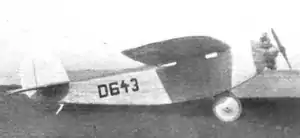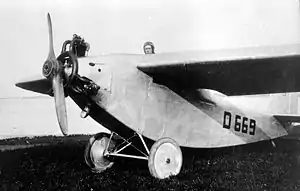LFG V 40
The LFG V 40 and V 44 were one-off, single-engine, two-seat sports monoplanes, identical apart from their engines, built in Germany in 1925.
| V 40 | |
|---|---|
 | |
| Role | Two-seat sports aircraft |
| National origin | Germany |
| Manufacturer | LFG (Luft-Fahrzeug-Gesellschaft) |
| First flight | 1925 |
| Number built | 2 (V 40, V 44) |
Design and development
The V 40 and V 44 were all-metal high-wing monoplanes, with thick, straight-edged, cantilever wings. Highly stressed members were steel, with duralumin elsewhere including the skin. The fuselages were deep-bellied and flat-sided with tandem open cockpits over the wing. On both aircraft, the pilot sat near the quarter chord position, with a slot in the fuselage below the wing to enhance his downward view, and the passenger was placed within a cut-out in the trailing edge. The tailplane was on top of the fuselage and the rounded vertical tail included a balanced rudder which extended down to the keel. The conventional undercarriage was fixed, with mainwheels on a single axle mounted on short V-struts and assisted by a tailskid.[1]
The V 40 and V 44 airframes were identical, but the V 40 was powered by a 75 hp (56 kW) Siemens-Halske Sh 11 7-cylinder radial and the V 44 by a 100 hp (75 kW) Bristol Lucifer 3-cylinder radial. Both were nose-mounted, uncowled, and drove two-blade propellers. External dimensions, apart from the exact length, were the same, and the weights were also similar.[1]
Operational history
The V 40 and V 44 were amongst five LFG entries to the Round Germany Flight held in the summer of 1925, though only the LFG V 39 took take part.[1][2]

Variants

- V 40
- 75 hp (56 kW) Siemens-Halske Sh 11 7-cylinder radial engine. One built.
- V 44
- 100 hp (75 kW) Bristol Lucifer 3-cylinder radial engine. One built.
Specifications
Data from Flight 28 May 1925 p.323-4[1]
General characteristics
- Crew: One
- Capacity: One passenger
- Wingspan: 11.4 m (37 ft 5 in)
- Wing area: 18 m2 (190 sq ft)
- Gross weight: 829 kg (1,828 lb)
- Powerplant: 1 × Siemens-Halske Sh 11 7-cylinder radial, 56 kW (75 hp)
- Propellers: 2-bladed [2]
Performance
- Maximum speed: 150 km/h (93 mph, 81 kn)
- Landing speed: 75 km/h (46 mph)
References
- "The round-Germany flight". Flight. Vol. XVII, no. 22. 28 May 1925. pp. 323–4.
- "Some impressions of the round-Germany flight". Flight. Vol. XVII, no. 23. 4 June 1925. p. 343.